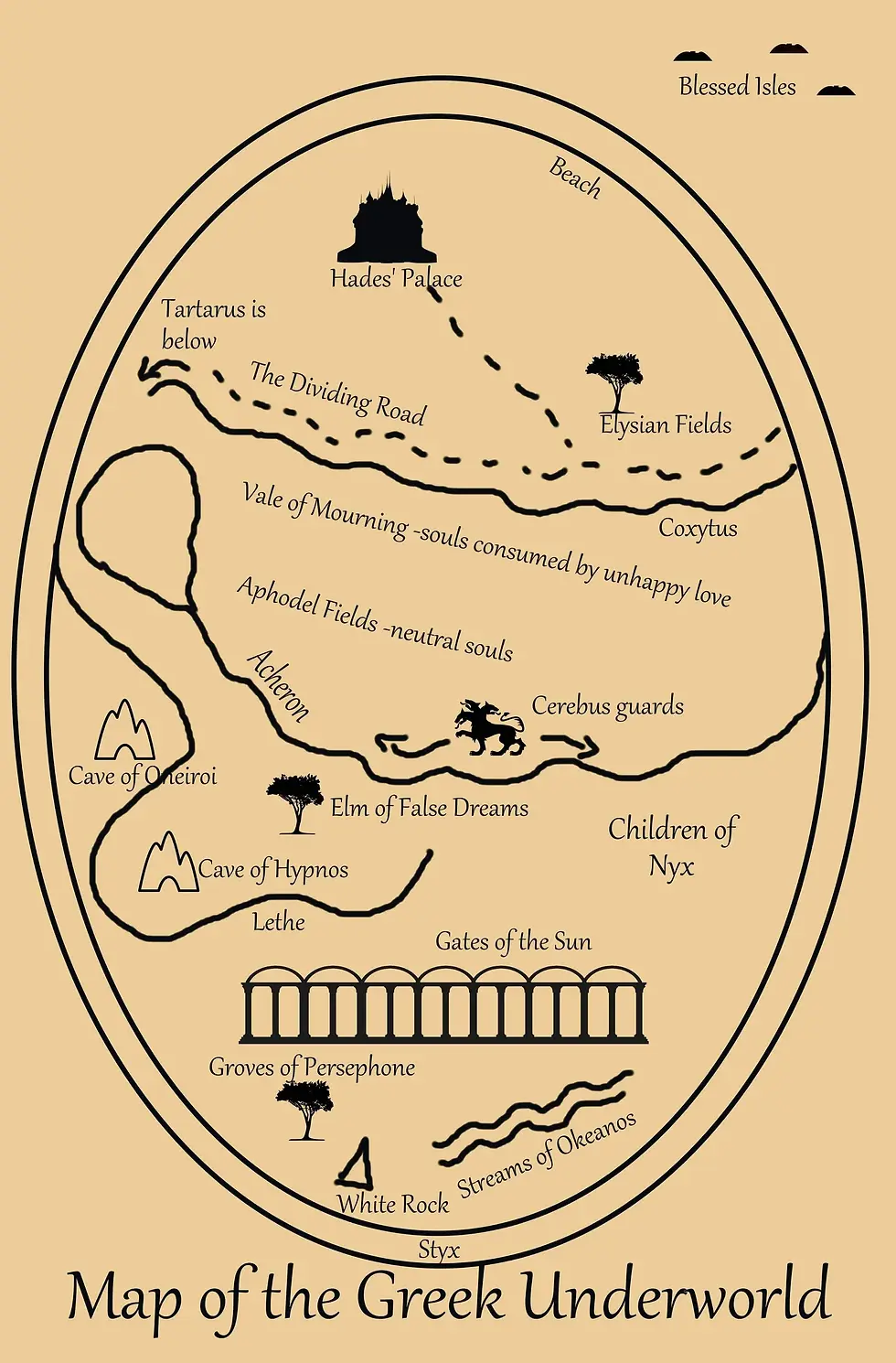The Geography of the Ancient Underworld
- Sophie Yang
- Aug 4
- 4 min read
Updated: Aug 11
Modern conceptions of the afterlife are rather binary. As a result of Christianity, we often tend to imagine a rather binary heaven or hell. There’s little clarification as to what determines the amount of “goodness” or “badness” an individual racks up over time, and once they die, their souls are either sent up to the sky with the other “good” souls to wander about the clouds for eternity or sent down to the magma coated fields of hell, tortured by fire and little demons for eternity.
As a classicist, I’ve always found this simple perspective on life after death rather demotivating. Ancient heroes—mortals and demigods alike—always entered the Underworld with a purpose. Orpheus broke the divine code and entered the Underworld as a mortal to retrieve his dead wife. Odysseus went to the Underworld to find a way back home. Aeneas, the founder of Rome, passed through countless trials to speak to the passed souls of his father, his Trojan followers, and even the souls of his future descendants, the Roman race. The Underworld contained past, present, and future; the mortal and the divine; blessings and curses.

The Ancient Underworld consisted of an extremely complex geography. The Underworld was divided into various parts by 5 major rivers: the Styx, Lethe, Acheron, Phlegethon, and Cocytus. To enter the Underworld, one would first have to find its entrance. There is only a small number of known entrances to the Underworld. Lake Avernus, located in Cumaë, was used by Aeneas. There is also a small cave near the city of Taenarum, near Sparta, which was used by Orpheus, Psyche, and Heracles (Hercules). The widely regarded ‘main entrance’ to the underworld was through the river Oceanus, which Hermes guided Odysseus through in the Odyssey. In case the waters of Oceanus are not enough to stop living trespassers from entering the Underworld, the Styx also encircles it 7 times.

The Styx, otherwise known as the river of hate, is the first major river of the Underworld. The Styx held immense power. Even the gods feared swearing an oath by its name. It was believed that the Styx’s water had the power to make anyone invincible. The Styx is known for being the river which Thetis, Achilles’s mother, dipped Achilles in as an infant, making him completely invulnerable with the exception of his heel. Three-headed Cerberus stands guard on the banks of the Styx, preventing people from entering.
The first thing you’ll see after crossing all 7 banks of the Styx are the Grove of Persephone. The grove houses hundreds of willow and poplar trees. Past the groves are the Gates of the Sun, which take you into the territory of Nyx, the primordial goddess of Night, and all her children: hydras, chimeras, gorgons, etc.
On the left of Nyx’s land is the river Lethe, the river of oblivion or forgetfulness. Upon entering the Underworld, the dead would have to drink from it to forget their mortal lives.
On the other side of the Lethe lies the Land of Dreams, where Hypnos, the god of sleep, and the Oneiroi live. On the edge of the Land of Dreams, there is the elm of False Dreams.

That takes you to the bank of the Acheron, the river of woe. Though its name sounds miserable, the Acheron is actually where dead souls are taken to their afterlives by Charon, the ferryman. The Acheron surrounds the Fields of Asphodel, where perfectly ordinary, uninteresting souls go. It’s miles upon miles of grassy fields, with nothing but other souls in sight.
The Acheron then flows into 2 other Underworld rivers: the Phlegethon and the Cocytus. The Phelegethon, or the river of fire, takes you to the part of the Underworld that is filled by the fire of funeral pyres. The Cocytus, or the river of wailing, is where the souls of mortals who were not properly buried go to live in for all eternity.
The Cocytus flows down into Tartarus, a place that is even deeper than the Underworld. Tartarus strikes a similar comparison to that of Hell. It holds the prison of the Titans, who had wrecked havoc on Mt. Olympus in Theogony. The souls of the worst mortals, such as Tantalus and Sisyphus are punished there for all eternity.

Also leading into Tartarus is the Dividing Road, which takes you straight to Hades and Persephone’s palace. The road is also where the kings Aeacus, Rhadamanthys, and Minos reside. The 3 kings are tasked with judging the souls of the dead and assigning them to their respective afterlives, such as the aforementioned Fields of Asphodel and Tartarus. Only the most heroic and distinguished souls are sent to the third and final afterlife: the Elysian Fields. Those souls are also offered a choice: either, they can stay in the Elysian Fields for all eternity, or they can choose to be reincarnated 2 more times. If their soul is able to make it to Elysium all three times, they will be brought to the Isle of the Blessed, a beautiful paradise where only the greatest of heroes are allowed to enter.



Comments